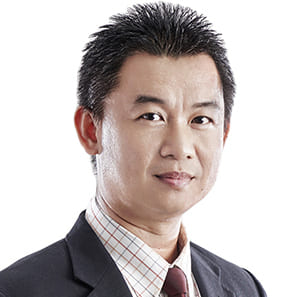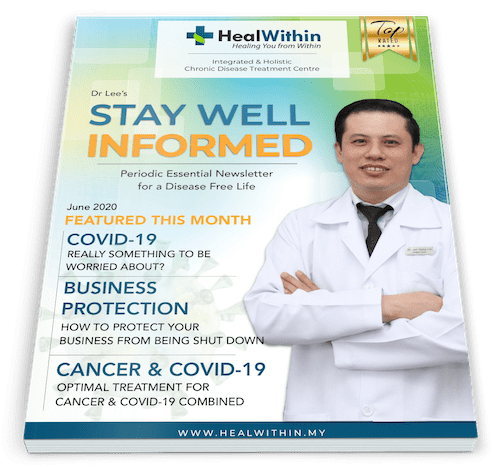Welcome to the first lesson in this “Post-Covid Syndrome” patient education series.
In this lesson I will present to you the necessary fundamental aspects of post-covid syndrome. Join me Dr. Lee as I navigate through a range of inquiries and impart my knowledge & expertise in this disease, and expand your acumen and deepen your understanding of this increasingly relevant condition.
What is Post-Covid Syndrome? #

Post-covid syndrome is a medical term for a set of symptoms that persist in a person even after the SARS-CoV-2 viral infection is treated and thereby COVID-19 is deemed resolved. In other words, a set of symptoms that persist in a person even after his/her SARS-CoV-2 viral infection is treated and COVID-19 disease is deemed cured is called post-covid syndrome.
To elaborate, Post-covid syndrome is a medical term for:
- Symptoms of SARS-COV-2 viral infection symptoms (COVID-19 symptoms) that continue & persist in an individual even after the infection is treated.
For example: If a person was infected by SARS-COV-2 and experienced COVID-19 symptoms – breathlessness, tiredness, brain fog, and poor sleep; and then was successfully treated for the viral infection (i.e. no more presence of SARS-COV-2 virus detected) and yet the symptoms of COVID-19 continued & persisted for weeks or months, then this person is said to have Post-Covid Syndrome.
AND/OR
- Symptoms of chronic diseases that existed prior to the SARS-COV-2 viral infection, that worsen & persist in an individual even after the SARS-COV-2 viral infection is treated.
For example: If a person had chronic gastritis and experienced symptoms of abdominal bloating and acid reflux, and later was infected by SARS-COV-2 and experienced COVID-19 symptoms – breathlessness, tiredness, brain fog, and poor sleep; and then was successfully treated for the viral infection (i.e. no more presence of SARS-COV-2 virus detected) but the person’s COVID-19 symptoms of gastritis (abdominal bloating and acid reflux) worsened & persisted for weeks or months, then person is said to have Post-Covid Syndrome.
What are the symptoms associated with post-covid syndrome? #
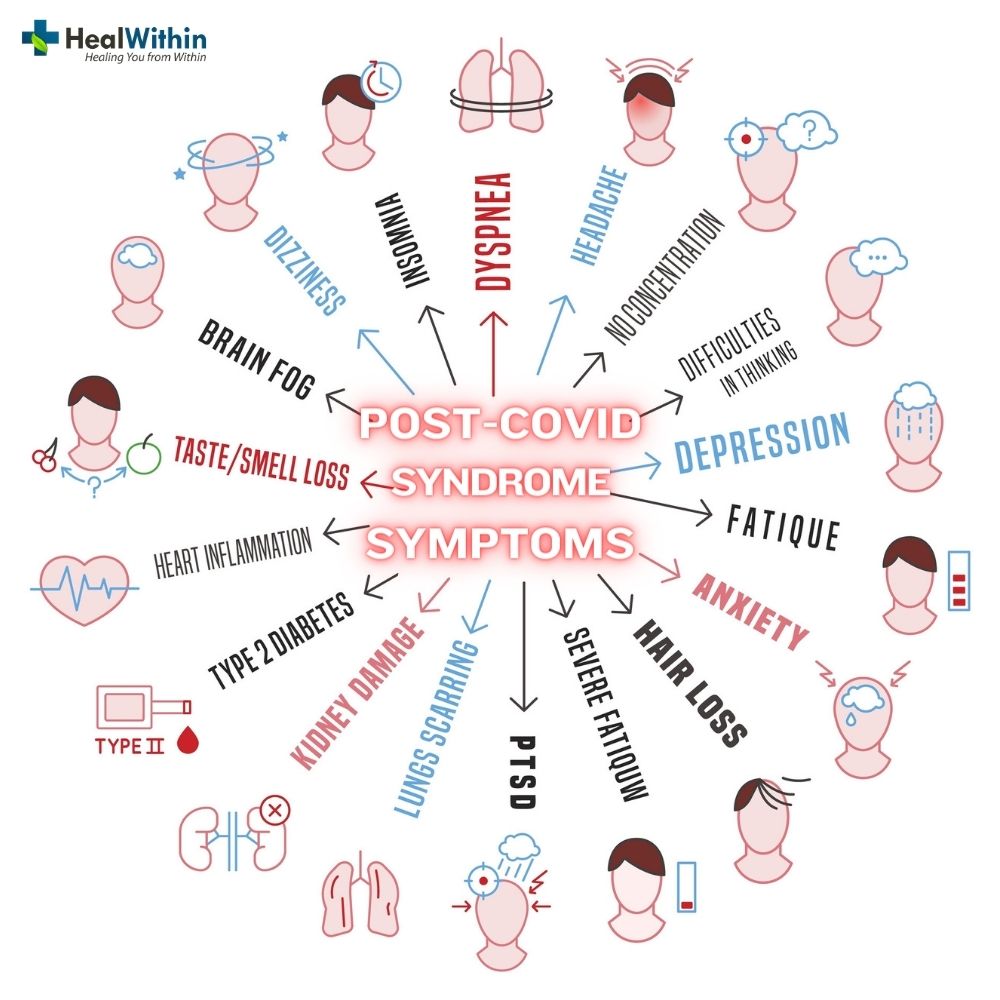
The symptoms associated with post-covid syndrome include:
- Fatigue
- Shortness of breath (breathlessness)
- Chest pain
- Heart palpitations
- Cognitive difficulties such as brain fog and difficulty with concentration and memory
- Sleep disturbances
- Skin rashes or itchiness
- Abdominal bloating or uneasiness
- Digestive problems
- Headaches
- Muscle and joint pain
- Loss of taste or smell
- Depression
- Anxiety.
** Please note that this is not an exhaustive list of all symptoms. Additional symptoms are still being reported constantly. The severity and duration of symptoms can vary greatly from person to person.
If the symptoms of COVID-19 and Post-Covid Syndrome are similar, how is it determined that an individual has post-covid syndrome and not unresolved COVID19? #
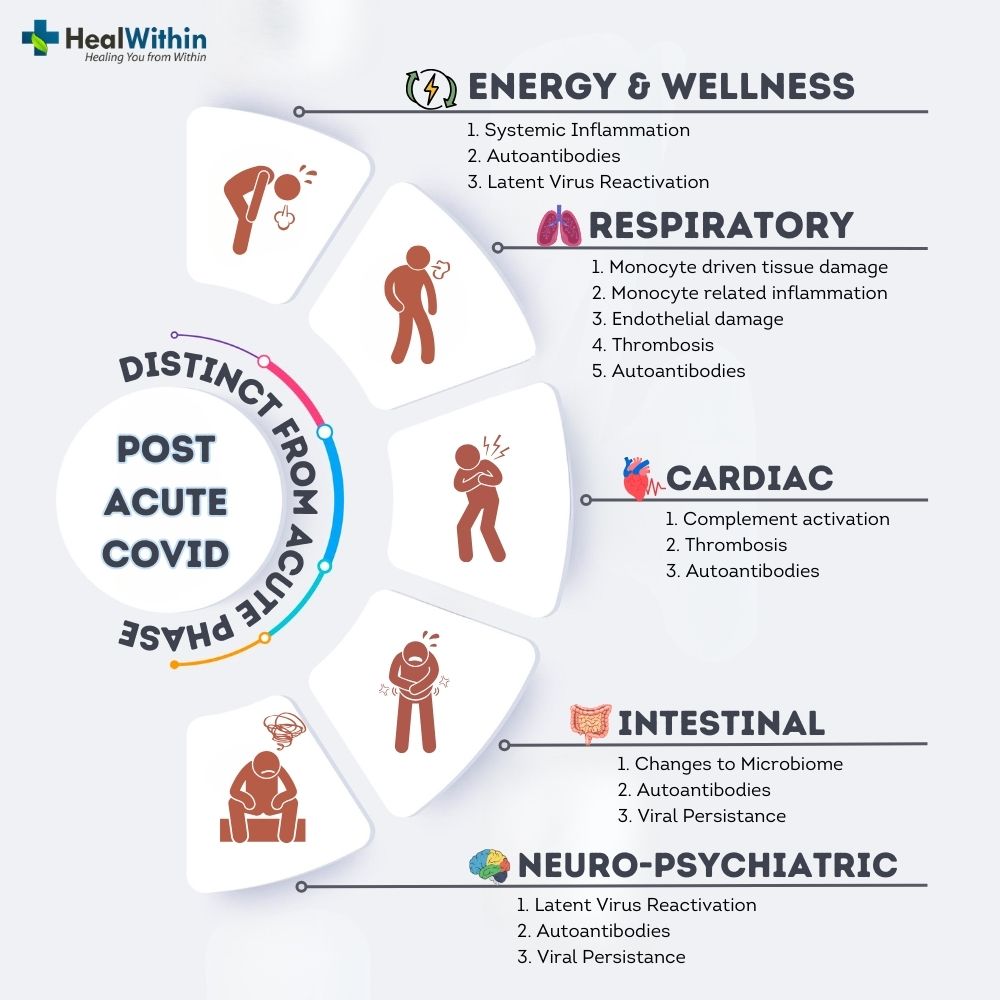
Determining whether an individual has fully recovered from COVID-19 and is experiencing Post-Covid Syndrome could be challenging if one tries to determine so just based on symptoms, because the symptoms of the two diseases can overlap. For this cause it is necessary for a patient to get help from a competent integrated & holistic medical doctor to determine whether he/she has COVID-19 or Post-Covid Syndrome.
Notwithstanding, for educational purposes here is a list of key factors that a competent integrated & holistic medical doctor would use to determine if a patient’s symptoms are associated with COVID-19 or with Post-Covid Syndrome:
- Medical history:
To know whether a patient had COVID-19 in the past or not, and thereby to help the medical doctor make an initial prognosis whether the symptoms are associated with COVID-19 or Post-Covid Syndrome. - Duration of symptoms:
Generally, symptoms of COVID-19 resolve within a few weeks, while symptoms of Post-Covid Syndrome can persist for several weeks or months. Again, this helps the medical doctor make an initial prognosis whether the symptoms are associated with COVID-19 or Post-Covid Syndrome. - RT-PCR test:
This test detects the presence of SARS-COV-2 viral infection and thereby establishes the patient to have COVID-19, which the medical doctor would use in determining whether the symptoms are associated with COVID-19 or Post-Covid Syndrome. - IgG Antibody test:
This test detects presence of IgG antibodies in the patient’s blood and thereby establishes whether the patient’s immune system is already trained to handle SARS-COV-2 viral infection or not. Patients with an immune system trained to handle SARS-COV-2 viral generally experience COVID-19 symptoms for just a few days. This test therefore helps the medical doctor his determination whether the symptoms are associated with COVID-19 or Post-covid Syndrome. - Chest X-ray and CT scans: These diagnostic imaging tests show conditions of the patient’s organs effected by COVID-19; the condition of the patient’s organs show different characteristics when in COVID-19 as compared to Post-Covid Syndrome. Therefore, the medical doctor would use these tests in determining whether the symptoms are associated with COVID-19 or Post-Covid Syndrome.
- Blood Inflammatory Markers test: Specific biomarkers from the blood including CRP, ESR, ferritin, etc., are used to determined inflammatory conditions in various organs. Generally, the levels of these biomarkers are different during COVID-19 and Post-Covid Syndrome. Therefore, these tests further help the medical doctor to in his determination whether the symptoms are associated with COVID-19 or Post-covid Syndrome.
- Clinical examination: The medical doctor would perform a physical examination to know if there be any additional causes to the patient’s symptoms, which also helps to determine whether the symptoms are associated with COVID-19 or Post-Covid Syndrome.
What’s are the causes of post-covid syndrome? Why do symptoms of COVID-19 continue & persists even after treatment? #

The causes to Post-Covid Syndrome per witnessed by a large body of competent integrated & holistic medical doctors are:
- Continuance of immune system disregulation:
Immune system disregulation as it relates to COVID-19 is an abnormal response of the immune system to the SARS-CoV-2 virus.
During the acute phase of COVID-19, the immune system mounts a response against the virus in order to clear it from the body. In some cases, this response can be excessive, leading to a “cytokine storm” which is characterised by an overproduction of inflammation-causing molecules called cytokines. This can lead to severe injury in major organs especially in lungs and liver.
In some cases the immune system continues to produce cytokines and other inflammation-causing molecules long after the SARS-CoV-2 viral infection is treated. This causes ongoing inflammation and tissue damage in various organs, which ultimately causes the initial COVID-19 symptoms to continue & persist into Post-Covid Syndrome. - Exacerbation of inflammatory conditions associated with chronic diseases that existed prior to Covid19:
Some people have chronic diseases and their associated chronic inflammations in various organs prior to getting infected with SARS-CoV-2 virus. It is seen that in many of these people those chronic inflammations exacerbate and cause increased disease activity of those diseases that were present prior to their SARS-CoV-2 viral infection. This occurs because the immune response triggered by the SARS-CoV-2 virus further stimulates the existing chronic inflammatory processes and thereby worsens the associated chronic diseases and ultimately worsens symptoms and/or causes additional symptoms.
In many cases, this exacerbation of existing inflammatory conditions is seen to persists even after the SARS-CoV-2 viral infection is treated and COVID-19 is deemed to be resolved, which causes the initial COVID-19 symptoms to continue & persist into Post-Covid Syndrome. - Exacerbation of silent inflammatory conditions that existed prior to COVID-19:
Some people have underlying silent inflammatory conditions prior to getting infected with SARS-CoV-2 virus. These underlying silent inflammatory conditions can range from subclinical autoimmune conditions to silent infections and may not present any noticeable symptoms.
However, when these people get infected with SARS-CoV-2, the immune response to the virus is seen to exacerbate the underlying silent inflammatory process, leading to increased COVID-19 symptoms and potentially even clinical manifestations of those silent inflammatory conditions.
In many cases, this exacerbation of existing underlying silent inflammatory conditions is seen to persists even after the SARS-CoV-2 viral infection is treated and COVID-19 is deemed to be resolved, which ultimately causes the initial COVID-19 symptoms to continue & persist into Post-Covid Syndrome. - Unresolved damage to organs that happened during SARS-CoV-2 viral infection:
Some people experience a severe case of COVID-19 wherein the SARS-CoV-2 viral infection results in damage to various organs in the body, including the lungs, heart, liver, and kidneys. This damage may occur consequent to the virus directly attacking these organs or due to a hyper immune response to the virus.
In some cases, this damage in organs is not fully resolved even after the SARS-CoV-2 viral infection is treated and COVID-19 is deemed to be resolved, which ultimately causes the initial COVID-19 symptoms to continue & persist into Post-Covid Syndrome.
Which COVID-19 patients are at risk to experience post covid syndrome? and why? #
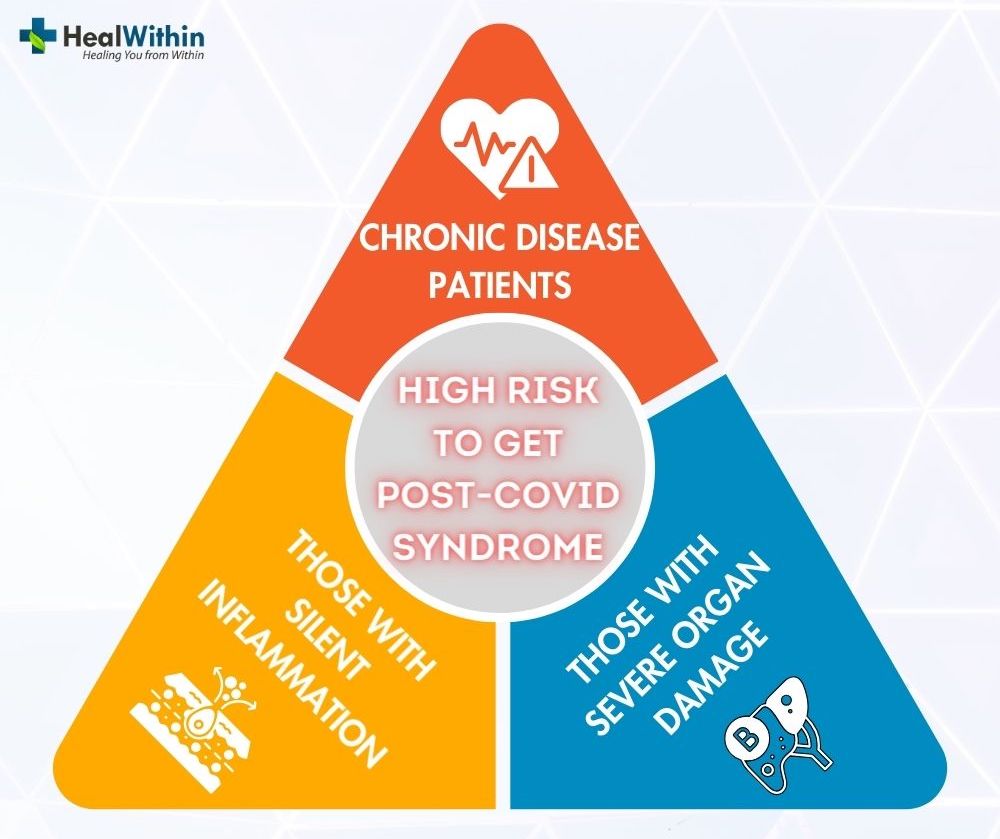
The answer to this question is closely related to the answer presented to the prior question. COVID-19 Patients that are at high risk to experience Post-Covid Syndrome are:
- Those that had any chronic disease and their associated inflammatory conditions prior to COVID-19:
This is because, the immune response triggered by the SARS-CoV-2 virus is seen to further stimulate existing chronic inflammatory processes and thereby exacerbate chronic inflammatory conditions associated with those chronic diseases and thereby worsen symptoms and/or causes additional symptoms which can continue & persist even after the SARS-CoV-2 viral infection is treated and COVID-19 is deemed resolved, thus putting people with existing chronic diseases at high risk to experience Post-Covid Syndrome. - Those that had diabetes and its associated inflammatory conditions prior to COVID-19:
Among chronic disease patients, those patients that have diabetes prior to COVID-19 are ones with the highest risk to experience Post-Covid Syndrome.
Diabetes is a chronic disease characterised by high levels of glucose in the blood due to insulin resistance or inability of their pancreas to produce insulin. This elevated glucose level contributes to chronic systemic low-grade inflammation (low-grade inflammation throughout the body), which can damage blood vessels and organs over time.
When an individual with diabetes is infected with SARS-CoV-2, the immune response to the virus can stimulate the existing systemic low-grade inflammations and thereby worsen damages in organs & blood vessels and thereby worsen symptoms and/or cause additional symptoms that can continue & persist even after the SARS-CoV-2 viral infection is treated and COVID-19 is deemed resolved, thus putting people with existing Diabetes at high risk to experience Post-Covid Syndrome. - Those that have Silent Inflammatory Conditions prior COVID-19:
Silent Inflammatory Conditions are chronic conditions that produce low-grade inflammation in the body, but do not present any symptoms. Some examples of these conditions include metabolic syndrome, subclinical autoimmune conditions, and certain types of chronic infections.
When a person with a Silent Inflammatory Conditions is infected with SARS-CoV-2, the immune response to the virus is seen to stimulate those low-grade inflammations and thereby exacerbate the underlying Silent Inflammatory Conditions and thereby trigger a variety of symptoms. This exacerbation of existing Silent Inflammatory Conditions can continue & persist even after the virus has been cleared from the body and COVID-19 is deemed resolved, thus putting people with existing Silent Inflammatory Conditions at high risk to experience Post-Covid Syndrome. - Those that got heavy damage to any organ by a SARS-CoV-2 viral infection.
In some COVID-19 patients it is seen that the SARS-CoV-2 virus causes significant damage to various organs – including the lungs, heart, and nervous system.
If a person gets heavy damage to any organ by a SARS-CoV-2 viral infection and the damage is not resolved even after the virus has been cleared from the body, then this can result in symptoms of COVID-19 to continue & persist into Post-Covid Syndrome even after the SARS-CoV-2 viral infection is treated and COVID-19 is deemed resolved, thus putting people with heavy organ damage during COVID-19 at high risk to experience Post-Covid Syndrome.
For example, people with significant lung damage during COVID-19 may continue to experience respiratory symptoms such as shortness of breath and fatigue; people with heart damage during COVID-19 may experience cardiac symptoms such as palpitations and chest pain; even after the SARS-CoV-2 viral infection is treated and COVID-19 is deemed resolved.
What about patients that fully recovered from COVID-19 and have no symptoms; are they at risk to get post-covid in the future? #
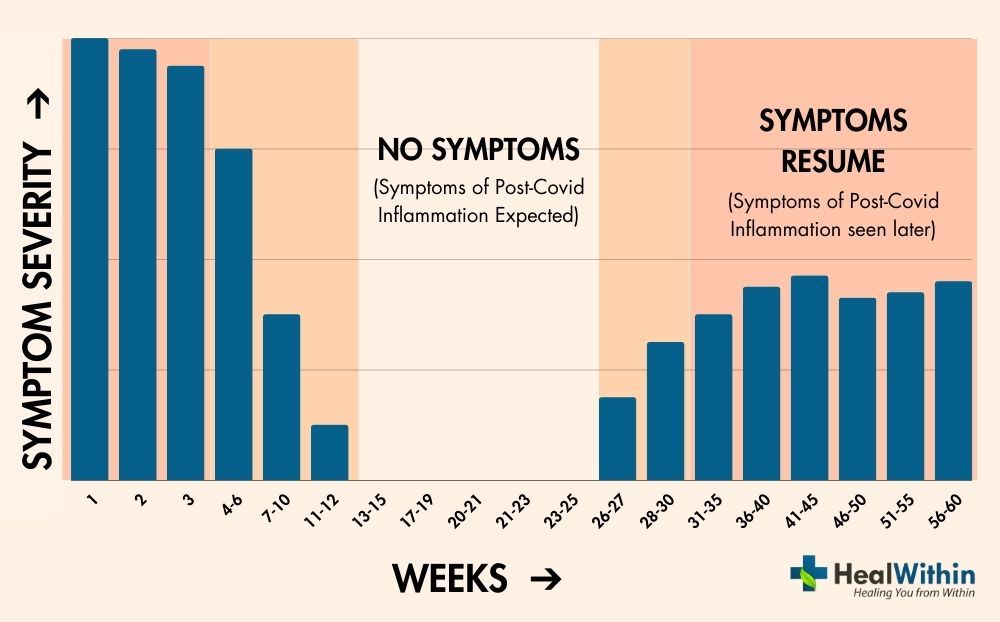
Yes, it is possible that a person who has fully recovered from COVID-19 and thence has no symptoms can still develop Post-Covid Syndrome sometime later, even months after their initial infection was totally resolved. This could happen because of:
- Unresolved Silent Inflammatory Conditions that exacerbate slowly over time and trigger symptoms after reaching a certain conditional threshold:
Silent inflammatory conditions are chronic conditions that produce low-grade inflammation in the body but do not present any symptoms. Some examples of these conditions include metabolic syndrome, subclinical autoimmune conditions, and certain types of chronic infections.
When a person with existing silent inflammatory conditions is infected with SARS-CoV-2, the immune response to the virus is seen to exacerbate the underlying silent inflammatory conditions and thenceforth trigger a variety of symptoms. However, in some cases this exacerbation of existing underlying silent inflammatory conditions is seen to happen long after the viral infection is treated and its symptoms are resolved.
For example – a person that had existing silent inflammatory conditions got a SARS-CoV-2 viral infection (got COVID-19) in March, and within two weeks was successfully treated and showed no more symptoms, but later that year in October started experiencing symptoms without having any SARS-CoV-2 viral infection (without getting COVID-19), because the exacerbation of this person’s existing silent inflammatory conditions happened slowly over time and triggered symptoms after reaching a certain conditional threshold. - Unresolved mild organ damage that worsens slowly over time and triggers symptoms after reaching a certain organ-damage threshold:
After being infected by SARS-CoV-2 virus, some COVID-19 patients get damage to some organs including the lungs, heart, and nervous system. However, the level of damage in organs could vary from mild to severe in different patients.
If a COVID-19 patient gets mild damage to an organ during an initial viral infection phase, then gets successfully treated for the infection and deemed cured from COVID-19, but still has that mild damage to that organ, then the mild damage in that organ could worsen slowly over time and trigger symptoms much later after reaching a certain organ-damage threshold.
For example – a person got a SARS-CoV-2 viral infection (got COVID-19) in February and consequentially got mild liver damage, and within two weeks was successfully treated for COVID-19 and showed no more symptoms. But because his mild liver damage was not detected and not treated, the damage got worse slowly over time and later that year in November the person started experiencing symptoms without having any SARS-CoV-2 viral infection (without getting COVID-19).
Can post covid syndrome be treated and resolved? #
Short answer, Yes. But there are nuances that you need to understand.
As explained above, Post-Covid Syndrome is only a term for a set of symptoms experienced by a person even after a SARS-CoV-2 viral infection is treated (even after COVID-19 is treated), which are caused by either one or more of – Continuance of immune system disregulation triggered by the viral infection, Exacerbation of inflammatory conditions associated with chronic diseases that existed prior to COVID-19, Exacerbation of silent inflammatory conditions that existed prior to COVID-19, and/or Unresolved organ-damage that happened during COVID-19.
You should never seek to treat Post-Covid Syndrome. Why? Because by doing so you would end up only suppressing symptoms by use of symptom-suppressing treatments. Instead, you should seek to find & treat the underlying causes to Post-Covid Syndrome which I’ve already listed and explained in much detail throughout this lesson.
Therefore my precise answer to this question is – Yes, Post-Covid Syndrome can be treated and resolved, only if all it’s underlying causes and root causes are treated & resolved.
In Heal Within®, my treatment protocol for Post-Covid Syndrome is based on finding & treating all it’s known causes & root-causes. Patients are taken through a series of medical tests to know the current condition of their immune system and thereby diagnose if there is Post-Covid immune disregulation, and to know the current condition in all organs in their body to diagnose if there is any organ damage or any silent inflammatory conditions in them. Then based on the results of those medical tests, a comprehensive treatment program is planned and a combination of various necessary therapies are administered. The ultimate objectives of the treatment being – Holistic Healing (induce healing in the patient’s whole body and restore it back to normal health as much as possible), Recurrence Prevention (Prevent recurrences of Post-Covid Syndrome), and Long-term wellbeing (induce optimal health for long-term wellbeing).
If you or a loved-one has Post-Covid Syndrome and seeking to get well, our treatment in Heal Within® can help.





